#black tortoiseshell blotched tabby with white
Text

Black tortoiseshell blotched tabby with white - f 09 22
Genotype: A_ D_ E_ ii mcmc Oo spsp titi wsw
Model: Nuka Dobry Duch of the Bukowa Dolina Cattery
Amber tortoiseshell with white - ft 09
Genotype: aa D_ ee ii mcmc Oo spsp titi wsw
Model: Frozen Land's Intense Jasmine of the Whiteberry Cattery
(What do these letters mean?)
#polls#cats#tournament poll#nfo color tournament#round 6#black tortoiseshell blotched tabby with white#amber tortoiseshell with white
46 notes
·
View notes
Text
Glossary
Agouti: Ticked Tabby without residual markings, lacks banding on legs and tail.
BCR: Burmese Color Restriction, Sepia.
Blue Cream: Blue Tortoiseshell, Dilute Tortoiseshell.
Braided: Mackerel tabby affected by the bengal modifier gene, causes stripes to split vertically with a hollow center. May also be referred to as “candle flame.” Applicable to Toyger.
Bronze: Black Spotted Tabby. Applicable to Egyptian Mau.
Brown: Black-based Tabby. Followed by description of pattern type, i.e. Brown Classic Tabby. Synonymous with “Sable” in Burmese, referring to Black Sepia.
Buff: Cream.
Calico: Tortoiseshell and White, ratio is loosely defined. Typically characterized by large patches of distinct color without brindling.
Cameo: Red Silver, Red Smoke. Followed by description of tabby type if known, i.e. Cameo Mackerel Tabby.
Champagne: Chocolate Mink.
Chestnut: Chocolate. May be stated on it’s own if self or followed by a description of pattern, i.e Chestnut Tortoiseshell. Applicable to Oriental breeds.
Chinchilla: Shell. Applicable to British breeds.
Cream Cameo: Cream Silver. Followed by description of tabby type if known, i.e. Cream Cameo Mackerel Tabby.
Ebony: Black. May be stated on it’s own if self or followed by a description of pattern, i.e Ebony Spotted Tabby. Applicable to Oriental breeds.
FEX: Full Expression, no color restriction gene.
Flame: Red-based color restriction. Applicable to the colorpoint, mink and sepia patterns.
Gray: Blue.
Lavender: Lilac. May be stated on it’s own if self or followed by a description of pattern, i.e Lavender Classic Tabby. Applicable to Oriental breeds.
Lynx: Tabby with color restriction. Applicable to the colorpoint, mink and sepia patterns but most often used alongside colorpoint.
Marbled: Classic tabby affected by the bengal modifier gene, results in dark-outlined blotches with paler colors in the center. Pattern is oftentimes more chaotic than the typical classic tabby. May refer to the standard, typical classic tabby pattern in breeds unrelated to Bengals.
McTabby: Mackerel Tabby.
Melanistic: Black Solid. Applicable to Bengal.
Natural: Black Mink, Seal Mink.
Orange: Red.
Patched: Tortoiseshell Tabby, Torbie. Followed by description of tabby type if known, i.e. Patched Classic.
Platinum: Lilac Mink or Lilac Sepia.
Rosetted: Spotted tabby affected by the bengal modifier gene, results in larger spots with hollow centers of color distinct from the base coat. Applicable to Bengal.
Ruddy: Black-based Agouti with high rufousing giving an auburn appearance. Synonymous with “Usual.” Applicable to Abyssinian and Somali.
Sable: Black Sepia, Seal Sepia. May be followed by description of pattern, i.e. Sable Tortoiseshell.
Seal: Black-based color restriction. Applicable to the colorpoint, mink and sepia patterns.
Sorrel: Cinnamon-based Agouti with high-rufousing giving a warm orange appearance. Also known as “Red” in applicable breeds. Applicable to Abyssinian and Somali.
Snow: Colorpoint, mink or sepia color restriction. Applicable to Bengals.
Tipped: Shaded. Applicable to British breeds.
Usual: Black-based Agouti with high rufousing giving an auburn appearance. Traditional color of applicable breeds. Synonymous with “Ruddy.” Applicable to Abyssinian and Somali.
29 notes
·
View notes
Text
Here is an example of Medieval theme naming and roles! What do you guys think?
Allegiances of the beginning of the First Rise of Change Arc!:
Note: I tried to list the cats under each category in order of oldest to youngest.
THUNDER KINGDOM
Monarch:
Monarch Blue of Frost - short furred, tall, slender, solid blue-gray molly, with blue eyes and some white and a distinctive white diamond star shape on her chest.
Apprentice: Squire Fire
Advisor:
Advisor Red of tails - small, long furred, tortoiseshell tom with a distinctive ginger tail and orange eyes.
Apprentice: Squire Dust
Herbalist(s):
Herbalist Spotted of leaves - beautiful, fluffy, dark tortoiseshell molly with a distinctive dappled coat and orange eyes.
Captain:
Captain Lion the heart - large, fluffy, golden, ticked tabby tom with fluffy thick fur around his neck like a lion's mane and green eyes.
Apprentice: Squire Gray
Knights:
Senior Knight White the storm - long furred, gray tabby colorpoint tom with blue eyes.
Apprentice: Squire Sand
Senior Knight Tiger the claw - big, long furred, dark brown tabby tom with unusually long front claws and amber eyes.
Apprentice: Squire Raven
Knight Dark of stripes - fluffy dark gray tabby tom with dark black stripes and yellow eyes.
Knight Bird of flight - short furred, slender, brown tabby tom with some white and a distinctive white blotch on his chest, and upper lip, and green eyes.
Knight Willow of pelts - short furred, very pale solid gray and spotted cream molly with green eyes.
Knight Down the nose - short furred, tall, long limbed, white molly with distinctive large floppy ears and blue eyes.
Knight Cricket the step - very small, short furred, prettily handsome, white cat with black and orange calico patches and orange eyes.
Knight Mouse of furs - small dull brown ticked tabby molly with yellow eyes.
Knight Shrike of tails - tall, long limbed and tailed, pale brown tabby tom with dark black stripes with some white and green eyes.
Apprentices:
Squire Dust - buff, chubby, dark brown sepia color point tom with white on his muzzle, paws, tail tip, and as a small patch on his chest and purple eyes.
Squire Raven - small, scrawny, long limbed, solid black tom with a white patch on his chest, white-tipped tail, a scar over his left eye and purple eyes.
Squire Sand - a yellowy cream tabby and solid black tortoiseshell molly with a distinctive black marking covering exactly half her face and one orange eye in the black, and one green eye in the cream.
Squire Gray - fluffy, chubby, gray tabby tom with dark gray stripes, some white and orange eyes.
Squire Fire - a short, very chubby, handsome, long furred, bright ginger ticked tabby tom with some white and green eyes.
Queens:
Senior Knight Speckle the snap - long furred cream ticked tabby tortoiseshell with gray speckle patches on her back and covering her tail and golden yellow eyes. She is the oldest nursery queen.
Senior Knight Golden the flower - beautiful, long furred, golden cream tabby molly with golden yellow eyes.
Senior Knight Frost of furs - a sleek long furred, beautiful, white molly with a gray and orange tabby calico patch over one eye, and a mostly orange calico tail with one blue eye and one green eye.
Knight Brindle the beauty - short furred, gray-brown and orange tortoiseshell molly with green eyes and some white.
Elders:
Elder Small the ear - small, short furred white tom with orange tabby patches and battered torn ears and green eyes.
Elder Sparrow of pelts - big scruffy furred dark brown tabby tom with half of his tail missing and green eyes.
Elder Fog of talons - pale blue-gray molly, with some white, as well as one clawed out eye and one yellow eye.
Elder Thrush the cloud - medium furred, sandy brown ticked tabby tom with some white, and green eyes.
Elder Dapple of tails - round, chubby, short furred, white molly with black and orange calico patches and dappled spots and yellow eyes.
Elder Rose of tails - long furred, gray and red calico molly with a distinctive fluffy rosey red tail and yellow eyes.
35 notes
·
View notes
Note
Telly I see you talk about your kitties often and I was wondering if you have a designated kitty reference post? I wanna know more about your lil creatures c:

@thebardisabird Ahh I don’t have a reference post, but I definitely want to make one now! With pictures and everything. Maybe even a sideblog only for pictures of them, since there’s no shortage of animals around here, heh (for people who don’t know it yet, my parents run an animal shelter out of our family home since I was a kid!)
But I can list them all and some basic info about them so you guys can know who’s who for now:
Cats who live in my room + the catio area:
Cobalto (blue lynx point tabby, male)
Turquesa (blue and white, female)
Royal (blue and white tabby, female)
Celeste (colorpoint and white, female)
Safira (black and white, female)
Petróleo (black, male)
⬆️ These six are siblings!
Soufflé (long haired black and white, male)
Quiche (tabby and white, male)
⬆️ Those two are brothers!
Pistache (long haired tortoiseshell, female)
Pretzel (black, female)
Napoleon AKA Leon (tabby and white, male)
Ganache (long haired black smoke and white, female)
Bombom (long haired black smoke, male)
⬆️ Those two are mother and son!
Cats who live in the kitchen area + my mom’s room:
Chaves (black, male)
Susuwatari AKA Susu (long haired black, male)
⬆️ Susu is Chaves’ father and Chaves is Pretzel’s father!
Sirena (tabby and white, female)
Nemo (tabby and white, male)
⬆️ Those two are mother and son as well!
Saga (tabby and white, male)
Frodo (tabby and white, male)
Savannah (blotched tabby, female)
Tiffany (blue, female)
Domino (calico, female)
Lollipop (colorpoint and white, female)
Francine (colorpoint, female)
⬆️ She’s Leon’s mother!
And that’s all of them! There’s the dogs as well and my two rats but if I were to list them all here this post would be a mile long.
6 notes
·
View notes
Text
The Fascinating World of Cat Coat Patterns: A Look at What Makes Each One Unique
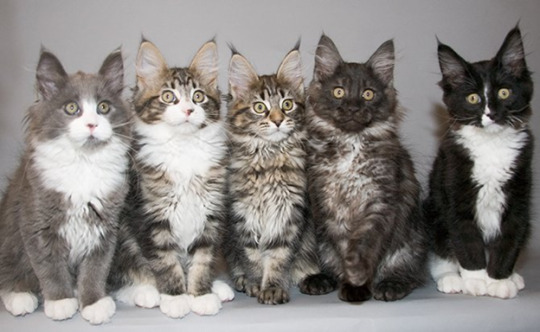
Introduction
Welcome to our exploration of the diverse and enchanting world of cat coat patterns! Cats capture our hearts and imaginations with their myriad colours and patterns. But have you ever wondered which cat coat pattern is the most popular or sought-after? In this journey, we'll delve into the beauty and uniqueness of various cat coat patterns, from the sleek solid black to the intricate tabby and everything in between.
Whether you're a cat lover, a curious reader, or considering adopting a feline friend, join us as we uncover the charm and popularity of these feline coat patterns, piecing together what makes each one special in the eyes of cat enthusiasts worldwide.
Common Cat Coat Patterns and Colors
Determining the most popular cat coat pattern involves different factors, including commonality, adoption rates, and people's preferences. Cats' various coat patterns and colours are uniquely appealing, influenced by cultural perceptions, breed characteristics, and individual preferences.
Solid Black: These cats are quite common but face a challenge in adoption due to superstitions. Nonetheless, their sleek and sophisticated look is appealing to many.
Solid White: Known for their bright, eye-catching coats and often having green or blue eyes, solid white cats are visually striking. However, many white cats, especially those with blue eyes, maybe deaf.
Tabby: is the most recognisable pattern, seen in various colors and featuring stripes or swirls. The primary tabby patterns include orange and grey, with additional sub-patterns based on stripe location.
Tortoiseshell: Featuring a mix of black, orange, and white patches, tortoiseshell cats are mostly female due to the genetics of their colouration.

Calico: Similar to tortoiseshells, calico cats display a combination of black, orange, and white but with more distinct blotches and a predominantly white background.
Reverse Calico: These have the same colours as regular calicos but with reversed dark and light patches.
Blue: Cats with a blue (slate grey) coat are often found in breeds like the Russian Blue, British Shorthair, and Chartreux.
Red: A rarer colouration ranging from light orange to deep red-brown, often seen in tabby patterns rather than as a solid colour.
Smoked: These cats have fur that is white at the roots but darkens toward the tips, commonly seen in long-haired breeds like the Maine Coon.
Bi-Colour: Typically consisting of two colours, black and white, these cats often include tuxedo cats and can be found in various other colour combinations.
Popularity and Preferences
A survey by the University of California, Davis, showed that people attribute different personality traits to cats based on colour, indicating that colour can influence adoption and preference. For instance, orange cats were perceived as friendly, while tri-coloured cats were considered more intolerant.
The Discerning Cat website also lists tabbies, tortoiseshells, calicos, and colours as some of the cats' most common colour patterns, further highlighting the prevalence and likely popularity.
According to a survey by The Catnip Times, people's preferences for cat breeds (and potentially their coat patterns) may also correlate with their personality types, as defined by the Myers-Briggs framework. However, the survey noted a general preference for domestic shorthair cats, indicating a shift towards favouring mixed-breed cats over purebreds for reasons beyond just coat patterns.
Conclusion
While it's challenging to pinpoint a single most popular cat coat pattern, tabby, calico, tortoiseshell, and bicolour patterns are among the most common and widely recognised. These patterns are cherished for their aesthetic appeal and diversity in the feline world. Individual preferences for cat coat patterns may vary greatly based on personal experiences, cultural backgrounds, and even personality types, making every cat coat unique and appealing in its own right.
0 notes
Note


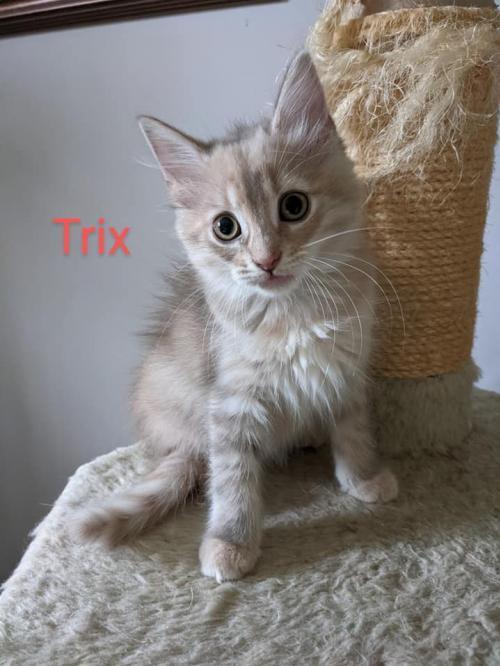

hi! i've been following your blog for a bit now and i love your posts about cat genetics. i was wondering if you could help me figure out the colors/patterns of these two pretty girlies.
for penny i was wondering if she could possibly be a diluted bengal since her spotted tabby markings look a bit rosetted.
for trix im not sure if she's a) a chocolate silver classic tabby/torbie or b) a fawn classic torbie. im leaning towards chocolate.
also here are the links to their profiles in case any of your followers are interested:
https://www.petfinder.com/cat/penny-53584807/fl/miami/furever-saved-fl1729/
https://www.petfinder.com/cat/trix-53333505/al/capshaw/forgotten-felines-inc-al143/
Penny is a beautiful red-spotted tabby with white, like this guy below!

from the photo you've sent, I'm not seeing anything that would indicate Bengal. I do see where you got confused because there are spot/stripes that are adjacent to each other in a way that could look connected, but that’s just how one copy of the spotted tabby gene + one copy of the mackerel tabby gene presents! rosettes have a dark outer outline and a light inner filling that is different from a cat’s ‘background’ colour
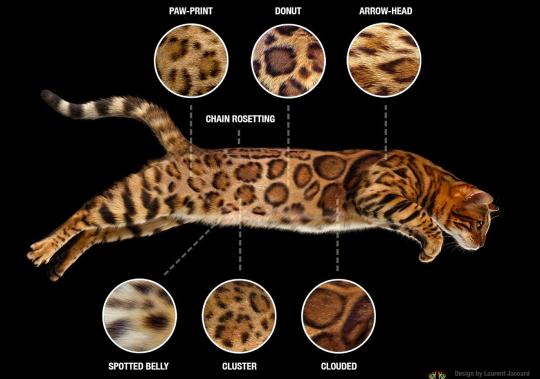
now onto Trix! fawn is a very rare colour, so unless the kitten is a purebred from a colour-oriented breed like Oriental Shorthairs, I wouldn’t consider that.
I don’t think she’s a chocolate silver torbie (chocolate + silver/inhibitor gene + tortoishell + tabby), because those tend to look darker and more.....well, chocolate!

she could be a blue silver torbie (dilute of black + silver/inhibitor gene + tortoishell + classic tabby), but her face looks quite light compared to the blue silver torbie below. it may just be the lighting in the photos, but none of the grey areas look particularly dark.

she’s pretty ambiguous, but I’m thinking lilac silver torbie? (dilute of chocolate + silver/inhibitor gene + tortoiseshell + classic tabby).
I wasn't actually able to find an example of this colouration online, but I did find a lilac silver tabby! if you pretend it has random blotches of cream areas, it does match up to Trix fairly well.

so you were very close with your chocolate silver torbie guess, just missing the dilution!
537 notes
·
View notes
Text
Kelusine Species Sheet
BASICS
Name: Kelusine
Height: 2’6”-6’0” at the shoulder
Weight: 900~ lbs-2000< lbs
Diet: Carnivore
Classification: Planetary, Natural, Non-Magic Sensitive, Sapient, Feral, Feline
Trainable: Yes
Temperament: Territorial, Protective, Energetic, Playful
Danger Level: Medium
Lifespan: 170-180 Kelusian Years
Litter size: 2-4 cubs
BIOLOGY
Morphology: Immense felines, they are quite similar to the big cats of Earth aside from their strong saber teeth (which range from 4-8 inches) and thumb-like appendages in place of their dew claws. Males have lion-like manes whereas the females sport a short mane along the nape of their neck. In certain subspecies that reside in colder regions (Mountaineers and Wastelanders), the females’ manes may extend to their shoulders and belly.
Subtypes:
Islander: The swimmers and climbers. Found in low level coast forests in tropical regions and, as their name suggests, on island chains connected by shallow expanses of ocean. The smallest species, this cat resembles a Cloud Leopard in structure and their ankles can rotate backwards, just like the real life cat’s. This enables them to climb down trees headfirst, climb upside down, or even hang by their back feet. These cats reach only two and a half feet at the shoulder.
Plainer: The runners. The second smallest in shoulder height (4 ft), yet the second longest (14ish feet) thanks to their lengthy tail, Plainers are built purely for speed. Living on the wide open grasslands, they rely on quick bursts of speed to take down their prey. Their long tail acts like a rudder, just like a cheetah’s would, which enables them to make sharp turns with minimal warning.
Forester: The jack of all trades. An intermediate of the five subspecies (4 ½ feet at the shoulder), Foresters resemble the tigers of Earth in build. Strongly built without sacrificing speed, Foresters live in, you guessed it, forests. They prefer hardwoods with mixed pines, but can adapt to Alpine forests or mid-latitude jungles and woodlands.
Mountaineer: The jumpers. Closely resembling snow leopards or mountain lions, Mountaineers are found in similar environments; high altitude snowy mountains. Thick fur keeps them warm in the frigid air, and a thick tail helps them balance while chasing prey across steep slopes. Unlike snow leopards, however, Mountaineers are immense and rank #2 height (5ish feet) and #1 in length from nose to tail tip (16ish feet).
Wastelander: The bone crushers. Unlike the other subspecies, which have body types based primarily on existing big cats, Wastelanders get their inspiration from smilodons and grizzly bears. Built for pure power with strong shoulders and immense front paws, Wastelanders are the largest of all Kelusines with shoulder height measuring six feet and even seven in rare cases. They are also the only subspecies with a short tail.
Colors:
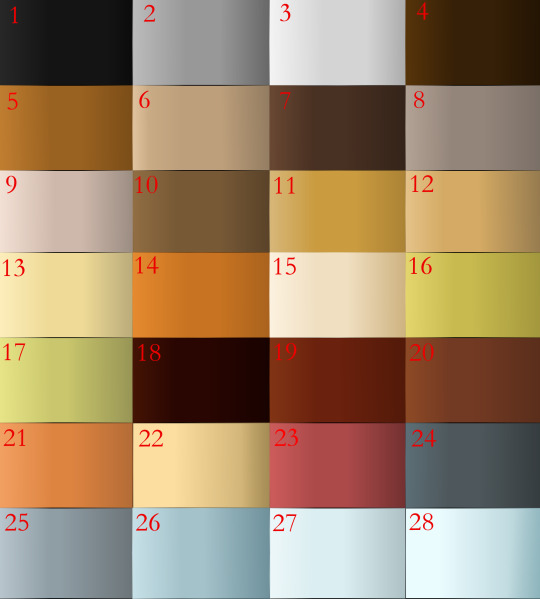
Standard:
Black
Grey
Silver
Brown
Light Brown
Tundra
Chocolate
Lilac
Fawn
Brown Ash
Golden
Tawny
Cream
Orange
Peach
Green Ash
Yellow Ash
Russet
Russet Brown
Cinnamon
Red
Strawberry
Red Ash
Blue
Blue-Grey
Chinchilla
Moonstone
Blizzard
Modifiers:
Colorpoint: Dilutes the base while leaving the extremities (face/tail/paws) normal
Reversal: Switches the color of the base coat and markings (ex: black with white stripes)
Light: Turns the inner marking of rosette/smeared/clouded/snow spot lighter than the base coat
Pied: White covers 25%-90% of the beast in solid patches
Splatter: White “paint splatters” cover 10%-50% of the beast
Tortoiseshell (Female only): The “red” gene is active and causes discoloration in patches.
Patterns:
Standard:
Common
Blotched Tabby
Brindle
Mackerel Tabby
Plain (no pattern)
Spotted Tabby
Ticked Tabby
Uncommon
Cheetah
Clouded
Dapple
Ocelot
Speckles
Rare
Double Dose (Spots on body and stripes on extremities)
Rosette
Snow Spot
Wild
Mutations:
Chimera (Two different base colors and markings)
Split (Two marking types)
Albino
Melanistic
Fallen Snow (Sabino along dorsal side)
Drift (Sabino along ventral side)
Glitch (Markings are broken and missing in some places)
Mist (Markings fade towards dorsal side)
Fog (Markings fade towards ventral side)
Storm (Markings in thin vertical bands)
Physical Mutations:
Mane:
Razorback (mane continues to tail)
Rimmed (mane along forelimb and back limb undersides; not found in Islanders or Plainers)
Curtain (long fur resemble horse mane; not found in Islanders or Plainers)
Static (Long and stiff along spinal area)
Scruff (Longer chin fur; standard Wastelanders)
Tail:
Bobtail (Stump)
Angel (longer silky fur)
Short (Akin to a wolf; standard for Wastelanders)
Ears:
Pointed (triangular rather than semi-circle; standard for Islanders)
Tufted (Lynx-like; standard for Wastelanders and Mountaineers)
Horned (Curl backwards)
Folded (Folded downwards)
HABITS
Habitat: Thanks to the abundance of specialized subspecies, Kelusines are one of the most diverse species in terms of location. They can be found almost everywhere apart from the far poles, deserts, and swamps. Large carnivores, they require an area rich in prey and thus control large swaths of territory either as a clan or as individuals.
Diet: Hypercarnivores, Kelusines require meat. They are not picky when it comes to meat, although shy away from carrion or cannibalism and a vast majority will not eat humans. One exception is the Wastelander subspecies, who will eat whatever prey they can catch. And humans are easy prey; dumb and slow.
Intelligence: Kelusines are one of the most intelligent animals of Kelusia. Like most creatures, they can speak Basic, or English. However, they are one of the few species that can learn languages other than their own and Basic. Kelusines are also one of the few that can operate high level technology. Some actually possess a Communication Watch on their wrists. Able to comprehend advanced math and science, Kelusines still prefer subjects that deal with history, natural science, and technology.
Social Life: Social creatures, wild Kelusines often live in small prides that consist of 5-7 individuals. However, sometimes to expand their territory, prides will join and make larger groups, or clans, of around 10-20 individuals, depending on the amount of prey available. When in clans, Kelusines have a ranking system to help things flow smoothly within the clan. The “head” positions are the Leader, Medic, and Deputy. Below that is the bulk of the clan, divided further into equal subgroups: Scouts, Operators (tech), Hunters, Guards, Milk Givers, and Elders. Below that rank the Trainees, who are the Kelusines ages 4-12 years, and finally come the Cubs, or Kelusines under the age of 4.
Life Cycle: Kelusine females carry for 9-10 months. There are 2-4 cubs in a litter, on rare occasions 5. The cubs are born helpless and cannot see or hear a week after birth. It is not uncommon for an expectant mother who resides alone to seek out a clan who will let her stay with them the first week or so after her cubs’ birth. She does this to ensure that her cubs are not killed by a rival or possibly a jealous male.
At two weeks, Kelusine cubs are stumbling around on stubby, unsteady legs. By now they can hear and see. They resemble fluffballs on sticks, their fur soft as down feathers. At three weeks, they can walk on their own without trouble and are play fighting with littermates or cubs near the same age if there are any. Around two months they are introduced to solid food. However, they continue to nurse until they are 9 months. At two years they begin to learn how to hunt for their own prey. They are usually taken out by both their mother and father if in a clan. If not, the mother or an older sibling will take them.
Kelusines are considered cubs until year four. By that time they are the size of a teenage tiger or lion. From year four to twelve they are considered adolescents. By now they are about the size of an adult lion or tiger. During the teenage years, Kelusines’ manes begin to grow. Their saber teeth also grow longer and stronger. Unless they grow up as rouges or loners, Kelusines begin to learn the basics of fighting at age twelve. If they were born outside of a clan, Kelusines often learn to fight sooner.
At sixteen years, Kelusines can make it on their own with no extra help. However, they are not considered full adults until age twenty. Females mature, both sexually and mentally, faster than males. They are considered mature at eighteen, while it takes males until year twenty. After a Kelusine reaches age twenty, they may leave to explore or may look for a job as a mount.
Kelusines are a unique species in that they are biologically immortal. The oldest Kelusine on record, a Forester by the name of Powerful Huntress of the Mountain Pass Pride, reached 220 Kelusian Years. However, most Kelusines only make it to 160-180 KY due to an oddity within their genes that becomes active around that age and produces similar symptoms to the viral infection rabies. Instead of intense fear, the Kelusine will become extremely aggressive, attacking anyone and anything in sight. This is not contagious, as it is not an infection, but there is also no cure for the affliction referred to as “Old Age Rage”. The only way to stop an OAR Kelusine is, unfortunately, to kill the beast.
Vocalization and Body Language: Like many of Kelusia’s unique fauna, Kelusines can speak Basic but also, as said earlier, have a unique ability to learn other languages such as Ragera. However, when they talk it is noticeably more guttural and rough compared to human speech. Aside from being able to speak “civilized” languages, Kelusines can make a wide variety of feral sounds. They have the ability to roar, snarl, growl, chuff, cough, groan, and hiss. Younger Kelusines can purr, but they do not have the ability to roar until age 5. Islanders and Plainers cannot roar no matter their age, but instead, like cheetahs, can purr through adulthood.
Kelusines are also heavily reliant on body language. Their body language heavily mimics the tigers of Earth. A calm Kelusine has a relaxed body posture, and the tail hangs languidly. When curious, their tail will be raised high in the air and their ears will be forward in interest. An aggressive Kelusine will bare its teeth, widen its mouth, enlarge its pupils, and flatten its ears.
OTHER
Ridability: Very human-like in their intelligence and readily available, Kelusines are not hard to come by. Kelusines are perhaps the most common mount as living with riders ensures a constant, easy food source while also making sure they get their exercise. That being said it is crucial for riders to understand Kelusines are not pets. Rather, they are companions who have agreed to carry the rider on their back. It is also important to keep in mind that, while Kelusines do have the intellectual capabilities of a human or higher creature, they are still highly dangerous predators who can turn on you if they so please. So treat them well.
Common Uses: Mounts, Guards, Guides, Rangers.
2 notes
·
View notes
Text
im not going to say it again
stripes, swirls, or uniform dotted array pattern = tabby
multicolor blotches of black, orange, and white, in an irregular, non-uniform arrangement across the body = tortoiseshell/calico
say it again for the people in the back
4 notes
·
View notes
Text
The Bengal Tabby Mix - General Information
New Post has been published on https://www.petculiars.com/the-bengal-tabby-mix-general-information/
The Bengal Tabby Mix - General Information
Although not among the most popular breeds of cats in the world, the Bengal cat is still recognized as one of the most athletic and active. With their muscled and lithe build, they will be able to jump very high in the air. Their complex physical appearance and their luxurious-looking coat are what make more and more pet owners in love with their looks. But before you buy it, is there any way of finding out of you’re getting a purebred or a Bengal tabby mix?
Bengal Tabby Mix: How to spot it
Tabby is not a specific breed but a coat pattern, which makes spotting a Bengal tabby mixed cat a pretty easy job. A tabby cat regardless of its breed will have stripes around the legs and tail, along its back, and also around the cheeks and eyes, and a very noticeable M-shaped marking on its forehead. Tabby cats, although different across breeds, will almost always be very smart, affectionate, and friendly with close people.
You might also like my articles on why would a cat have black boogers, why you shouldn’t cut a cat’s whiskers, and why won’t a cat eat prescription food.
Currently, there are five tabby patterns that are more popular, and these are:
The Spotted tabby – This cat will have either small or large spots all over the sides of its body, sometimes being very similar to mackerel stripes.
The Patched tabby – A cat that is usually known as either a tortie tabby or a tortoiseshell, with individual patches of red and brown tabby patterns. A tortie cat that also comes with tabby genes will be called a torbie.
The Ticked tabby – This type of cat won’t have too well-known traditional spots or stripes, except for some tabby markings on its face and some hairs that are striped with alternating dark and light bands.
The Mackerel tabby – This is what most people will call a tiger cat, with narrow stripes coming down in parallel on the sides in a vertical pattern. These stripes will usually look just like a fish skeleton.
The Classic tabby – This is the most common tabby and will have swirling patterns on the sides, similar to a marble cake. This cat is also known as a blotched tabby.
But what about the Bengal cat breed? What are its main physical traits and behavior particularities?
Bengal cats were made by crossbreeding the Asian leopard cat with a domestic cat to create a more obedient specimen but with an exotic appearance and a unique coat pattern and color. These cats are usually medium to large in size. The first time this cross between breeds was attempted was in the United States of America, around 1960. Except for the whisker pad, the chin, and the belly area, a Bengal will usually have no other white spots on its body. Instead, it will have a really nice-colored pattern. The tip of its hair strands will usually contain less pigment, which means that when light hits it, it will sparkle. The fur is pelted or soft and strands are individually ticked.
Common physical traits
Body length: 14 to 19 inches
Height: 8 to 10 inches
Weight: 12 to 16 pounds
Lifespan: 9 to 16 years
Coat length: short
Patterns: spots, ticking, tabby, rosettes (clouded, cluster, arrowhead, donut, paw print, spotted)
Colors: red, torbie, blue, cinnamon, black, seal, brown, silver, snow, or smoke
Eye color: orange, yellow, brown, or blue
You will notice that Bengals have a thick tail, large feet, and a thick neck, but also a triangular-shaped head. With a medium-length leg, they have really strong muscles they count on.
Personality traits and behavior
Although most people consider that Bengal cats are closer to wild animals than other breeds of cats, if you were to buy a domesticated specimen or one that has been separated from the wild for a few generations, you will notice it is more affectionate, loving and sweet. They will get very close to their owners and will be loyal for all their lives. You will have to match their energy because they really like to run, romp and jump around. This breed is also very alert and curious. This means that you will have to be prepared for an agile, playful, and energetic pet.
Although these cats like to climb in high areas and jump all-around your home during the day, they are loving and will demand your companionship throughout the night. Their strong memory enables them to learn tricks pretty easily and they can be taught to do anything from opening doors, to high fiving, sitting, and lying down. They will also learn most human expressions and gestures easily. They love to play around water and are in no way aggressive unless trained like that. Their constant need for stimulation can be kept under control with the use of interactive cat toys that can offer the needed exercise to your animals.
So, how does one ascertain if their cat is a Bengal tabby mix?
Considering the factors discussed above, it is safe to presume that your cat is a Bengal tabby mix if it possesses the characteristics of a Bengal cat but also has a distinctive tabby pattern. You may check your cat’s color markings and patterns and compare them with the common tabby patterns mentioned above to have an accurate match. You may also consult a local breeder or your veterinarian to help you in determining if your cat is a Bengal tabby mix if you have doubts.
Is it safe to own a Bengal tabby mix cat in a home?
Are there any legal issues?
To answer both questions at once, it is not only legal, but also safe to own a Bengal tabby mix cat in the USA, but also in Australia and Europe, as long as your cat will be separated from its wild ancestor, the Asian leopard cat, for more than five generations. Even though the vast majority of US cities will have no issues with you owning this kind of cat, there are others, and I must say, they aren’t small cities, like Seattle, Hawaii, Connecticut, and New York City, that won’t allow you to get this type of cat, regardless of their filial stage.
Conclusion
You will usually recognize a Bengal cat due to its athletic build, luxurious coat, and very affectionate nature. These cats are very smart, agile, and amazing jumpers. You should look in your cat for physical qualities, behavior, and temperament traits to see if it is a Bengal tabby mix. It should also have the unique tabby patterns in her coat.
0 notes
Text
What Color Is Your Cat?
Domestic cats come in four main colors.
Red / Orange (x)

Light Brown (x)
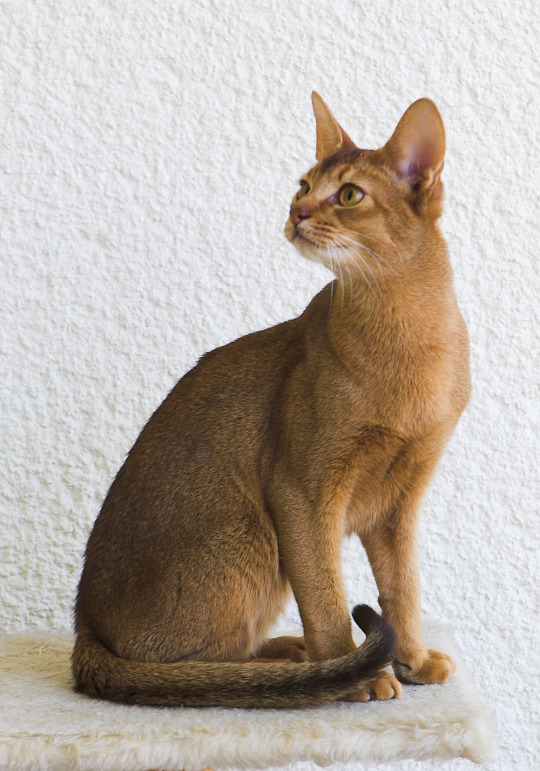
Dark Brown (x)
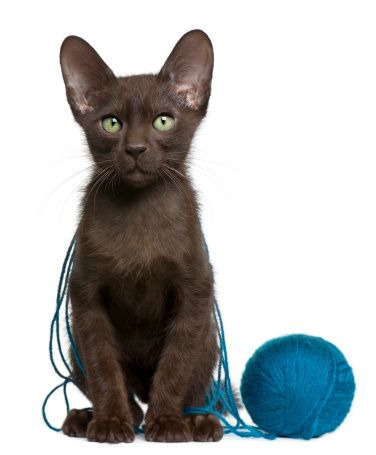
and Black (x)
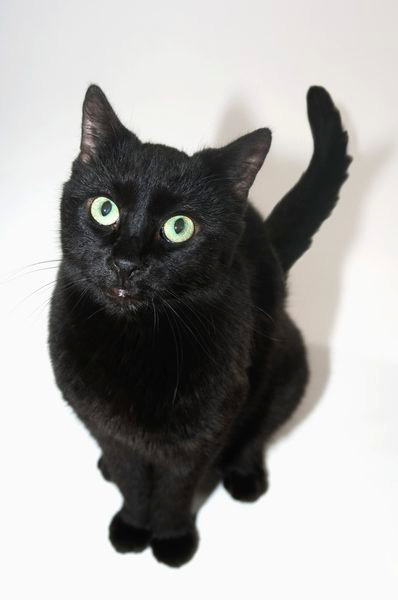
These four basic colors are the “deep” colors. This means the individual fur hairs have the color pigment all the way down the shaft. This creates a beautiful, “deep” color.
However, when the gene for agouti hairs is active, the pigment will instead gather in bands along the hair shaft. This creates a lovely “dilute” color that, to the naked eye, appears paler than the deep, nonagouti hairs. (x)
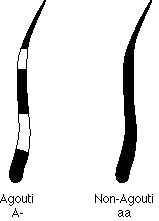
Instead of Red, you get Cream (x)
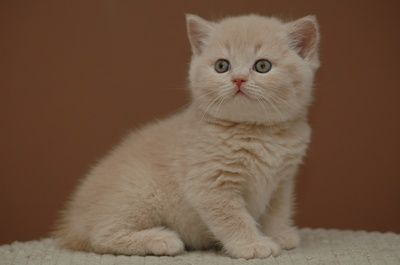
Instead of Light Brown, you get Fawn (x)
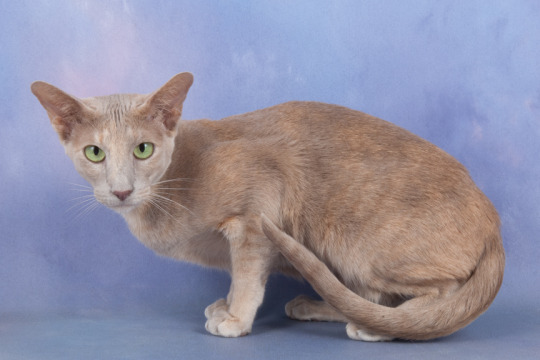
Instead of Dark Brown, it’s Lilac (x)
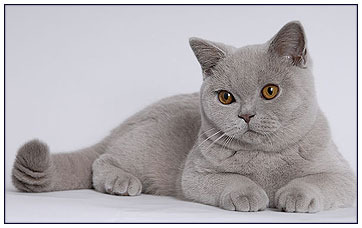
And instead of Black, it’s Gray / Blue (x)

There are also two special case colors. The first is white. White cats still contain the genetic markers for a non-white color, but the “white gene” masks that color and makes the hairs white.
The second special color is silver. A mutation that can happen to cats with any genetic color predisposition, it removes the yellowish or tannish pigment from the hairs, leaving them a beautiful silver instead. (x)

Except for black and gray, it usually takes special breeding to get a cat that is a solid color. Most cats will have a combination of colors and markings that makes them beautiful and unique.
Since they have a common ancestor in the African Wildcat, all domestic cats carry the gene for a tabby pattern. (x)
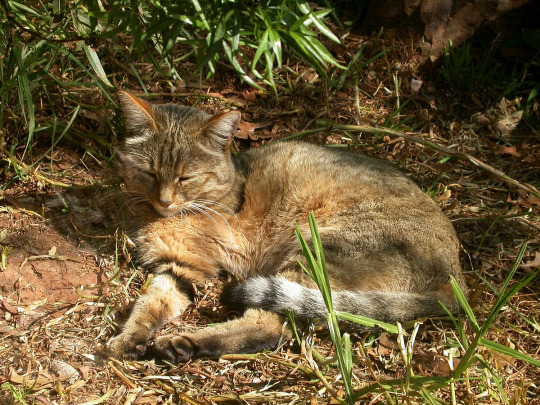
Even solid-colored cats will sometimes show a “ghost tabby” pattern under the right light, especially as a kitten. (x)
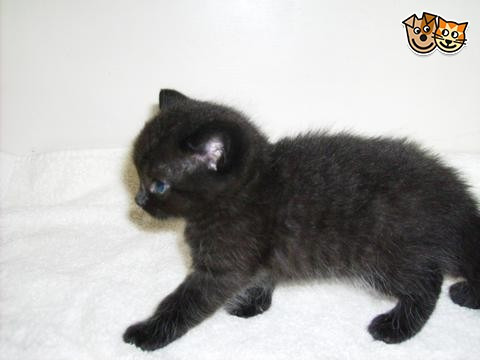
Patterns form when agouti hairs and nonagouti hairs gather in various patches, stripes, and dots on the cat. Where the nonagouti hairs gather, the cat will appear darker, and where there are more agouti hairs, the cat will appear lighter.
Is your cat a tabby?
As mentioned above, all cats carry the gene for the tabby pattern, though it is not always visible. There are four main kinds of tabby patterns.
Mackerel Tabby (x)
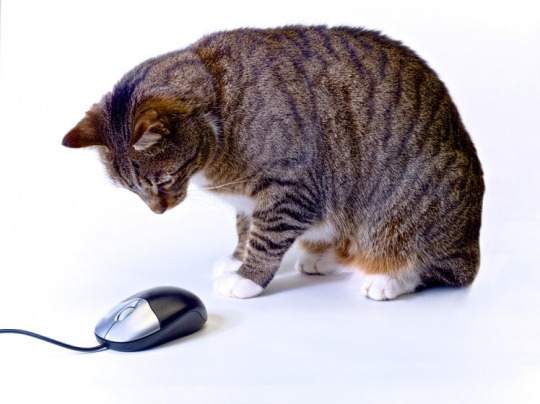
The original tabby pattern, it is so called because the stripes down the sides resemble the bones of a fish.
Classic Tabby (x)
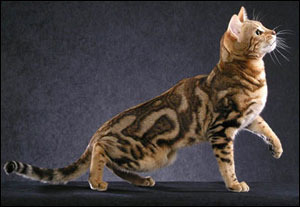
Also called a “blotched tabby.”
Spotted Tabby (x)

This pattern only rarely shows up in the domestic short- and longhair breeds. It usually requires special breeding to bring about.
Ticked Tabby (x)

A cat is considered a ticked tabby if her fur is almost entirely agouti hairs and has minimal visible pattern.
All tabby cats have an M shape on their foreheads. (x)
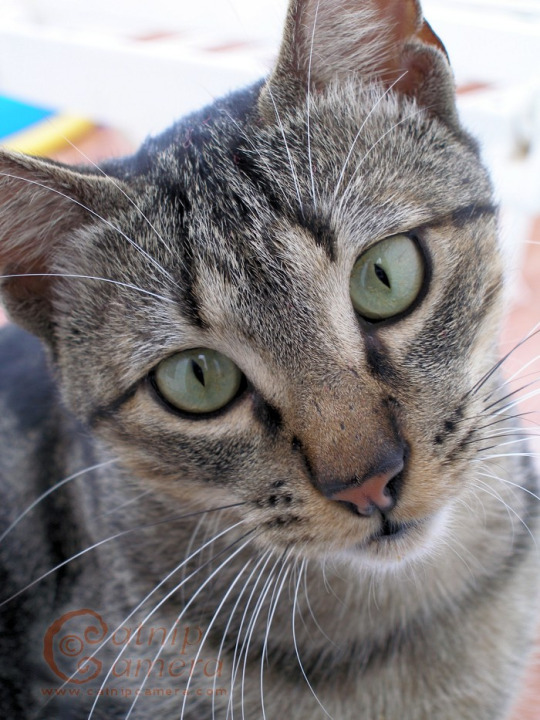
White patches? It’s piebald!
Piebald simply means your cat has white on it, but isn’t all white. There are different terms for piebald, or particolor, cats depending on the amount and placement of the white vs. the color.
Van (x)

Mostly white with patches of color mainly on the head and tail
Bicolor (x)
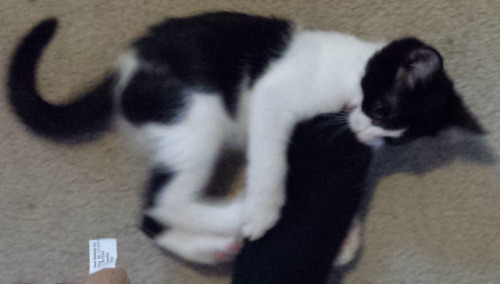
One to two thirds white, bicolor cats usually have color markings on their heads and torsos as well as tails.
Mitted (x)
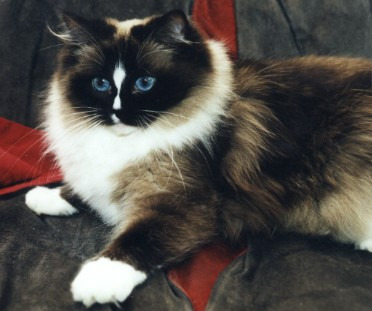
While mitted cats, obviously, have white on their paws, they can also have white on their chin, chest, belly, and back legs.
Lockets (x)
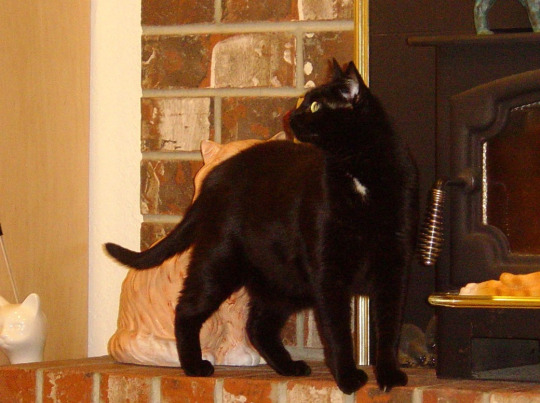
As you can see, the white patch looks like a locket on a necklace sitting on the chest. Small white patches can also be referred to as “buttons” and appear in other places on the body.
But wait... My cat is more colorful than that!
Tortoiseshell, or “Tortie,” patterns appear when a cat has two different color genes in her DNA and neither is dominant over the other. These colors are usually red and black, though other combinations can appear as well. Since the color gene is carried on the X chromosome, only female cats can exhibit tortie patterns. (The exception being an XXY intersex condition, but those males will be infertile.)
There are several tortie patterns...
Tortoiseshell (x)
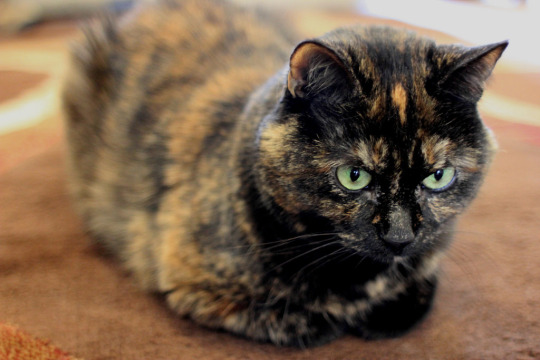
Classic red and black. Beautiful!
Calico (x)

When a tortie has patches of white, she’s called a calico.
Torbie (x)
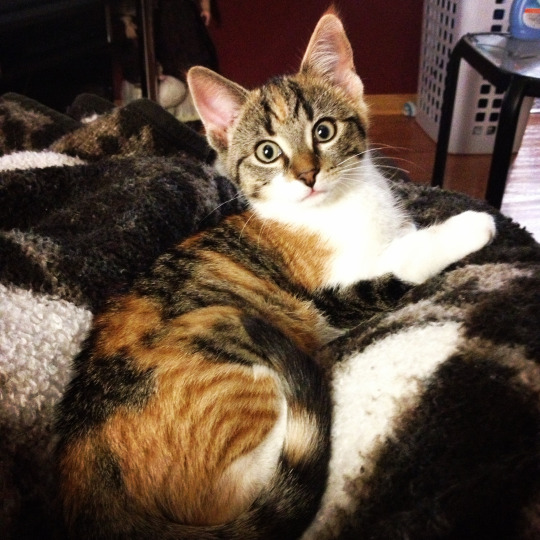
A tortie cat with a visible tabby pattern is called a torbie or patched tabby.
Pointed Cats
They’re not sharp and pointy--well, not more than any other cat. No, the term “pointed” refers to the fact that these cats have light-colored bodies with darker color appearing only at certain “points.” (Yeah, I would’ve come up with a better name too, but it’s stuck now.)
When thinking of a pointed cat, most people will think of the Siamese cat breed. They are pointed, but not all pointed cats are Siamese.
Colorpoint (x)
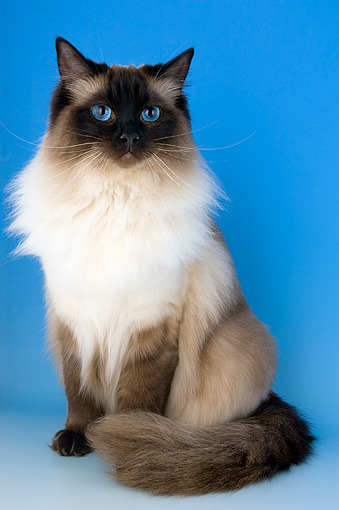
The darker patches are solid or unpatterned.
Tortie Point (x)
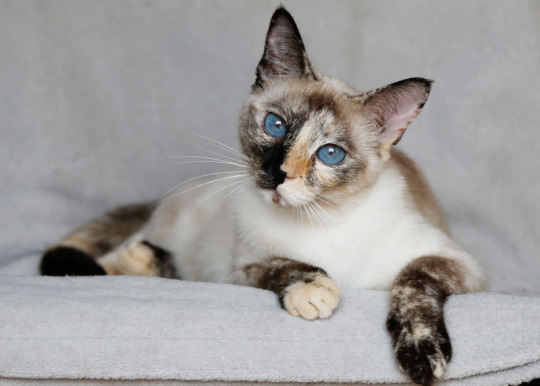
The darker patches have a tortie pattern.
Lynx Point (x)
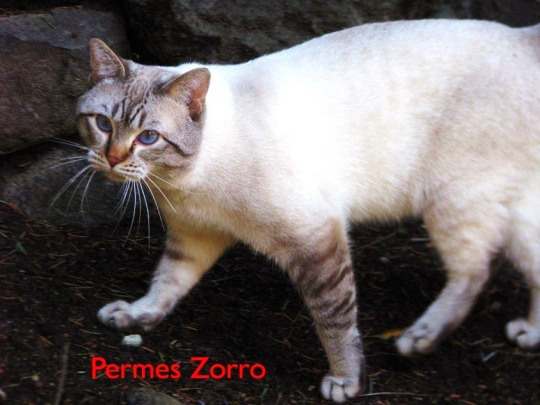
Lynx point patterns have stripes on the darker patches.
Tortie Lynx Point (x)

A combination of the tortie and lynx characteristics.
So, now that you have all the information you need, tell me
What Color Is Your Cat?
274 notes
·
View notes
Note
Thank you for flooding my dash with pictures of so many fluffy kitties :D
Didn't realize the tournament was starting yet but it brightened my day
I'm glad to hear it! 😸 Please have one (and a half) more fluffy kitty:

28 notes
·
View notes
Note
Ok. Rate cats based on pattern. Solid, tiger, tortoiseshell, calico, or indeterminate. Also, remember mug cakes? those microwave recipes that were all over for a while but just turned into egg rubber bricks when you cooked them? What happned to those, are we less gullible now or did some other snack fad replace them.
Solid White or solid Black > Tiger > Tortoiseshell > blotched tabby > calico
I never made a mug cake but mug cookies are fantastic. Even just using a couple cubes of store bought cookie dough still makes it delicious.
3 notes
·
View notes
Text
Wilds : CliffClan Allegiances
CliffClan
Leader : Mintstar - old, very light grey spotted tom with aqua colored eyes
Deputy : Smallrush - tiny, muddy brown tom with amber eyes
Medicine Cat : Sageleaf - white she cat with grey spotted tabby blotches all over her fur and leaf green eyes
Comfreypaw - pretty, blueish grey she cat with pale grey eyes
Warriors :
Blackcloud - tall, jet black she cat with yellow-green eyes and short fur
Thundercall - towering tortoiseshell tabby she cat with striking amber eyes
Dustbloom - pale cream tabby she cat with warm yellow eyes and fluffy fur
Wrentalon - light brown and white tabby tom with clear brown eyes
Viperstrike - muscular dark brown and black tabby tom with bright green eyes
Apprentices :
Jaggedpaw - dark greyish brown tabby tom with pale green eyes ; Mentor - Thundercall
Mothpaw - cream and white she cat with folded ears and yellow eyes ; Mentor - Viperstrike
Shadowpaw - tall, lanky dark grey tabby tom with warm brown eyes ; Mentor - Blackcloud
Queens and Kits :
Honeyshine - pretty, golden tabby she cat with spiky fur and bright yellow eyes
Boulderkit - big, dark brown tom with dull, grey eyes
Stonekit - handsome grey-brown tom with dark blue eyes
Blazekit - Fosterkit found at the border. Small, fluffy red tabby she cat with bright orange eyes
Elders :
Anttrail - brown she cat with black spots and dark brown eyes
Echostar - Mintstar's mother and the prior leader of CliffClan, decided to retire on her last life. Blueish grey she cat with dark grey eyes
#wilds#warriors#warriorsoc#occlan#warriorsallegiane#allegiance#ocallegiance#warriorcats#waca#cats#oc#CliffClan
0 notes
Text
The Fascinating Facts Behind Cat Colors
(adsbygoogle = window.adsbygoogle || []).push({ google_ad_client: "ca-pub-9215988308746328", enable_page_level_ads: true });
Cat colors, patterns and fur length are a cat's calling card. We include these features when referring to specific types of felines. For example, we would call fictional cat Garfield a red tabby Exotic Shorthair.
Note the color, pattern, coat and coat length in the name. The cat fancy – or the community of feline enthusiasts, cat show judges, breed registries, breeders and others who study and adore felines – gave us these designations to make it easier to identify cats.
This may seem hard to believe, but these are some of the most important things in the world. It almost does not seem fair when you get 15 vivid colors like pink, green, blue, yellow and purple.
"Birds derive from their brilliant coloring because of the chemical structure of their feathers and amino acid modifiers, which is different from that of cat coat textures where pigmentation is based on melanin types," says Joan Miller, the Cat Fanciers' Association's outreach and education chair. and renowned cat expert.
Cat colors – what coat colors can cats have?
Cats basically come in black, white or some combination, dilution or mixture of these. Photography by Casey Elise Photography.
Basically, when it comes to cat colors, they are black unless they have inherited the sex-linked orange masking gene, in which case they are red, Miller explains. By red, we mean what is usually called orange.
"The hundreds of colors and patterns displayed in domestic cat coats, which changes these basic colors," she says, giving an example of the dilute gene commonly called gray) and red to cream.
Polygenes, genes which require multiple others of their kind for their effects to be observable, then determine whether the color coat will be a dark steel gray-blue or pale powder blue, she explains. These inherited polygenes are controlled by selective breeding in pedigreed breeds. If you've studied for a long time, you probably know that it is wrong and it is wrong. That's because the orange gene is carried on the sex-linked X chromosome. Because they are XY with only one X chromosome, they can only be black or red (or the variations of each due to modifying factors).
Since females are XX, they can be both black and red. "This is how we get the flashy tortoiseshell-colored females, who have black coats with splashes of red. If the dilute factor is inherited, the female cat will be a blue-cream. Should this also be the case for the white spotting factor, then this female can be a white and white, or calico tricolor cat with large black and red areas on a white coat, "Miller says. Piebalds are spots or patches that are absent of pigmentation, or white.
Read more about cat color and genetics on Paws and Effect >>
The tabby pattern
When it comes to coat patterns, here's a mind-blowing fact: All cats start as tabbies. Photography by Casey Elise Photography.
When it comes to cat colors and coat patterns, here's a mind-blowing fact: All cats are tabbies. "Whether they show their tabby pattern or not depends on whether the cat has inherited the dominant agouti gene or the recessive non-agouti solid color gene," she explains. However, even solid-colored red cats will show tabby pattern because the sex-linked chromosome is not affected by the non-agouti gene. Solid-color kittens will sometimes show their underlying tabby pattern when young before their kitten coat and grows in. Also, when they have an eye to a solid coat of light, their underlying tabby pattern can often be faintly seen.
Classic tabbies, also called blotched tabbies, have a combination of stripes, swirls, blouses and what looks like a bull's-eye on the sides of their bodies.
Ticked tabbies have banding on each other's hair with a lighter color at the base, which creates an iridescent speckled appearance but without stripes on the body. Abyssinians and Somalis are these types of tabbies.
Mackerel tabbies have vertical continuous stripes on both sides of their bodies and shoulders to tail.
Spotted tabbies are just that. The size of the spots and the spacing between them vary. Ocicats have large thumbprint spots, Egyptian Maus have high-contrast, randomly placed spots of varied shapes and sizes, and Bengals have rosette spotting, according to Miller, "but random-bred cats will often have broken mackerel or classic striping giving a spotted appearance . "
There's also a pattern called patched tabby. These are some of the other tabby patterns that also show additional red-colored patches due to their inherited sex-linked orange gene, Miller explains.
The pointed pattern
The point-restricted pattern gives Siamese and related breeds their pointed pattern, or a light-colored body with darker colors at the extremities. Photography © studdio22comua | Thinkstock.
Here's another cool point about cat colors: The point-restricted pattern gives Siamese and related breeds their pointed pattern, or a light-colored body with darker colors at the extremities. The gene must be carried out for both men and women.
"The reason is temperature sensitive, the cause of extremity of the body – the face, ears, legs, tail and testicles," Miller explains. "It is part of the albino series and modified the color tone so that it appears black seal brown on a light fawn-colored body. The genetic mutation, its color dilution, and its dilute version, lilac, were also seen in the early Siamese cats. "Tonkinese cats, which are a mix of Siamese and Burmese, have a more subtle point contrast called mink coloring.
Siamese cats were named after the ancient kingdom of Siam, where they originated. "These cats were a sensation when first imported to England in the mid-1800s," Miller says. "When the Siamese first came to America in the early 1900s, they quickly became popular as far as the spread of the recessive point-restricted pattern throughout the country. It is still hidden in the genotype of many random-bred cats and surfaces in which the sire and dam are carriers of the gene.
Shading patterns
Three types of shaded cats include: chinchilla, shaded and smoke
the extent of the shading on individual hairs. Photography © Olivia | Thinkstock.
Another thing to consider when we're talking about cat colors? Shading, which is characterized by the color of the hair with a pure white undercoat. Three types of shaded cats include: chinchilla, shaded and smoke, each distinguished by the extent of the shading on individual hairs.
In chinchillas, only the tip of the guard, or outer coat, is colored. With the shaded pattern, a quarter of the guard hair farthest from the cat 's body exhibits the color. In the smoke pattern, half of the guard hair farthest from the cat's body displays the color. When a smoke-patterned cat is still, the coat pattern may appear solid, but when it catches you, you can see the white undercoat.
Bicolors and tricolors
The tortoiseshell, gold tortie, are referred to as particolored. These cats are female, and they are black with random patches of red. Photography by Casey Elise Photography.
With cat colors, people love to talk about bicolored cats, which are white and any other color. The cat can have a little spotting, or even a patch of white, or can be mostly white with a little bit of the other color. The colored area in bicolored cats can also feature any of the tabby patterns.
"The bicolor and tricolor patterns are created by the dominant white piebald-spotting gene," Miller says. "Polygenes help determine the amount of white in the cat's coat. Black bicolored cats with only a small amount of white, such as a 'bib,' white paws and perhaps a white facial 'blaze' are the 'tuxedo' cats. The other extreme is an almost entirely white body. This is called the 'Van' pattern referring to the cats found in the Lake Van area of Turkey centuries ago. "
Calicos are white females with large solid areas of black and red patches and other colors like blues and creams thrown in. They can have a little bit of white, a lot of white or anything in between.
Tortoiseshells, or torties, are referred to as particolored in the cat fancy. Like calicos, these cats are female, except they are black with random patches of red. The black and red can also be the dilute blue and cream. A dilute tortie is a blue female with patches of solid cream or chocolate with red gold lilac with cream. The patches on the tortoiseshell can also be tabby patterned.
Cat colors chart:
Solid coat colors in cats. Photography © Thinkstock Images.
Cat colors and cat personalities
Calico and tortoiseshell cats are female, because the orange gene is carried on the sex-linked "X" chromosome. Photography by Casey Elise Photography.
The University of California, Davis, surveyed 1,200 cat guardians in 2015 and published the results in the Journal of Applied Animal Welfare Science. The questions were asked to answer questions about their behaviors. The results are confirmed to be accurate and accurate.
In another survey, researchers from the University of California, Berkeley, and California State University, East Bay, asked 189 cat guardians to assign the terms – active, aloof, bold, calm, friendly, intolerant, shy, stubborn, tolerant and trainable – to cats of five different colors – red, tricolored, white, black and bicolored. Cats, intolerance to tricolored cats and aloofness to white cats.
Keep in mind that these were surveys of human perceptions, not scientific studies that controlled for other possible personality influencers, such as gender and coat length. Calicos and torties are female, which could play a greater role in personality than coat color. Longhaired cats are widely believed to be docile, while shorthaired cats are purported to be energetic.
I have two red tabby domestic longhaired cats who came from the same litter. Some of my friends can not tell them apart, But when it comes to personalities, the two could not be more opposite. One greets everyone who comes to our house; the other has enough love for me and my husband.
More studies are needed before we can conclude that cat colors influence personality.
Cat eye colors
A blue-eyed white cat. Photography by DONOT6_STUDIO / Shutterstock.
Another cool point to consider when it comes to cat colors – cat eye colors. All kittens are born with blue eyes. At about 6 to 8 weeks of age, "their final potential is apparent," Miller says. "Full brilliance is not achieved until a cat reaches maturity." Full maturity can take one to two years, depending on the cat breed. "There are only three basic eye colors," Miller says. "However, eye color of domestic animals is striking and greatly varied. Interestingly, the brilliant copper eye color of a Persian, the deep gold eyes of an Abyssinian or Bombay and the emerald green eyes of a Russian Blue are all derived from the same gene. It is through years of selective breeding that this extreme eye color spectrum has been perfected in the breeds. Random-bred cats usually have greenish gold or hazel eye color; however, a colony of free-roaming cats resulting from natural-line breeding will often develop golden or lemon-yellow eye color. "
Some cat eye colors are linked to coat colors or patterns. For example, white cats can have blue, yellow, gold or odd eyes. "Any cats that have inherited the piebald-spotting factor can have an eye-color – one blue eye and one golden, yellow or greenish eye," Miller says. Cats with the point-restricted color pattern, like the Siamese, have blue eyes because of a gene that is linked to albinism. Tonkinese often have aqua eyes. "Tonkinese showing the deeper Burmese coat colors (sand, blue, champagne or platinum) will have gold or green eye color," Miller says.
Thumbnail: Photography by Xseon | Shutterstock.
This piece was originally published in 2017.
Editor's note: Have you seen the new Catster print magazine in stores? Or in the waiting area of your vet's office? Click here to subscribe to Catster and get the bimonthly magazine delivered to your home.
About the author:
Author and Editor Susan Logan-McCracken shares her husband, Mark, and two red tabby domestic longhaired cats, Maddie and Sophie.
Read more about cats and science on Catster.com:
(adsbygoogle = window.adsbygoogle || []).push({ google_ad_client: "ca-pub-9215988308746328", enable_page_level_ads: true });
Source link
The post The Fascinating Facts Behind Cat Colors appeared first on Funny Cute Cats.
from WordPress https://ift.tt/2xUqjP6
via IFTTT
0 notes
Text
The Fascinating World of Cat Coat Patterns: A Look at What Makes Each One Unique
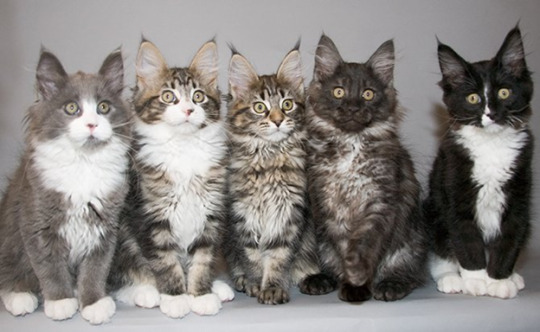
Introduction
Welcome to our exploration of the diverse and enchanting world of cat coat patterns! Cats capture our hearts and imaginations with their myriad colours and patterns. But have you ever wondered which cat coat pattern is the most popular or sought-after? In this journey, we’ll delve into the beauty and uniqueness of various cat coat patterns, from the sleek solid black to the intricate tabby and everything in between.
Whether you’re a cat lover, a curious reader, or considering adopting a feline friend, join us as we uncover the charm and popularity of these feline coat patterns, piecing together what makes each one special in the eyes of cat enthusiasts worldwide.
Common Cat Coat Patterns and Colors
Determining the most popular cat coat pattern involves different factors, including commonality, adoption rates, and people’s preferences. Cats’ various coat patterns and colours are uniquely appealing, influenced by cultural perceptions, breed characteristics, and individual preferences.
Solid Black: These cats are quite common but face a challenge in adoption due to superstitions. Nonetheless, their sleek and sophisticated look is appealing to many.
Solid White: Known for their bright, eye-catching coats and often having green or blue eyes, solid white cats are visually striking. However, many white cats, especially those with blue eyes, maybe deaf.
Tabby: is the most recognisable pattern, seen in various colors and featuring stripes or swirls. The primary tabby patterns include orange and grey, with additional sub-patterns based on stripe location.
Tortoiseshell: Featuring a mix of black, orange, and white patches, tortoiseshell cats are mostly female due to the genetics of their colouration.

Calico: Similar to tortoiseshells, calico cats display a combination of black, orange, and white but with more distinct blotches and a predominantly white background.
Reverse Calico: These have the same colours as regular calicos but with reversed dark and light patches.
Blue: Cats with a blue (slate grey) coat are often found in breeds like the Russian Blue, British Shorthair, and Chartreux.
Red: A rarer colouration ranging from light orange to deep red-brown, often seen in tabby patterns rather than as a solid colour.
Smoked: These cats have fur that is white at the roots but darkens toward the tips, commonly seen in long-haired breeds like the Maine Coon.
Bi-Colour: Typically consisting of two colours, black and white, these cats often include tuxedo cats and can be found in various other colour combinations.
Popularity and Preferences
A survey by the University of California, Davis, showed that people attribute different personality traits to cats based on colour, indicating that colour can influence adoption and preference. For instance, orange cats were perceived as friendly, while tri-coloured cats were considered more intolerant.
The Discerning Cat website also lists tabbies, tortoiseshells, calicos, and colours as some of the cats’ most common colour patterns, further highlighting the prevalence and likely popularity.
According to a survey by The Catnip Times, people’s preferences for cat breeds (and potentially their coat patterns) may also correlate with their personality types, as defined by the Myers-Briggs framework. However, the survey noted a general preference for domestic shorthair cats, indicating a shift towards favouring mixed-breed cats over purebreds for reasons beyond just coat patterns.
Conclusion
While it’s challenging to pinpoint a single most popular cat coat pattern, tabby, calico, tortoiseshell, and bicolour patterns are among the most common and widely recognised. These patterns are cherished for their aesthetic appeal and diversity in the feline world. Individual preferences for cat coat patterns may vary greatly based on personal experiences, cultural backgrounds, and even personality types, making every cat coat unique and appealing in its own right.
More articles are available at www.catlovercommunity.com
1 note
·
View note
Text

Black tortoiseshell blotched tabby with white - f 09 22
Genotype: A_ D_ E_ ii mcmc Oo spsp titi wsw
Black silver blotched tabby - ns 22
Genotype: A_ D_ E_ I_ mcmc oo/o- spsp titi ww
(What do these letters mean?)
#polls#cats#tournament poll#nfo color tournament#round 5#black tortoiseshell blotched tabby with white#black silver blotched tabby
26 notes
·
View notes